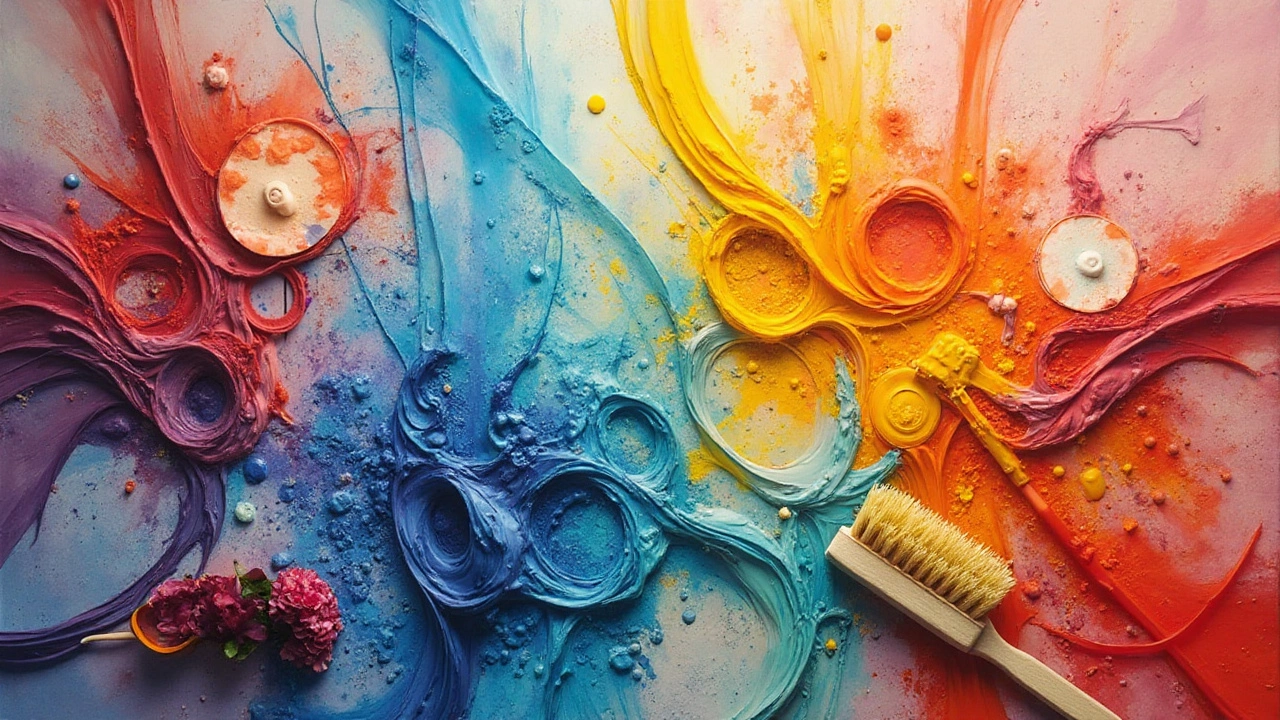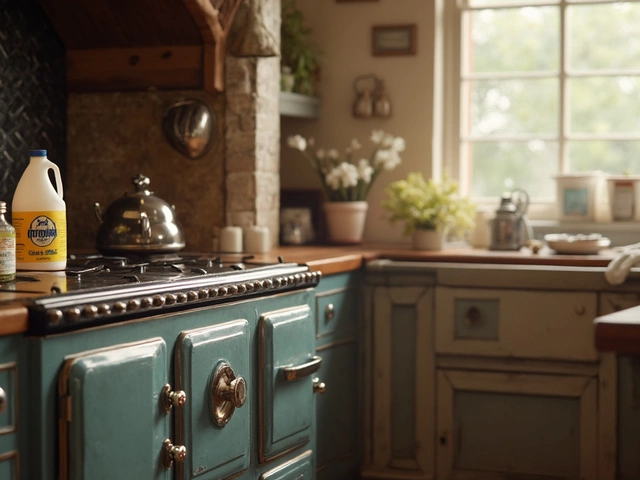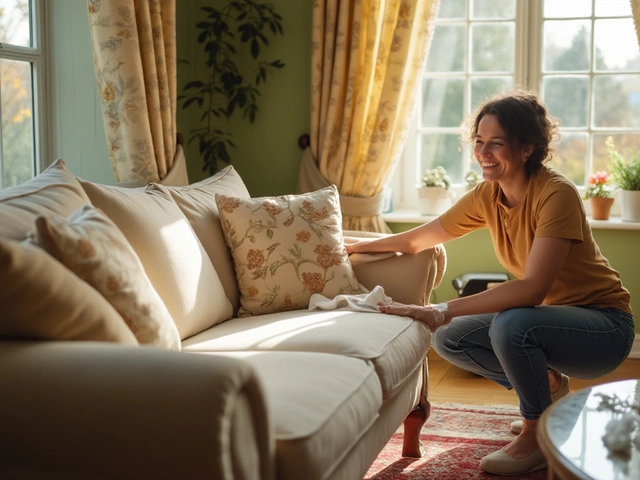Your couch is more than just a piece of furniture; it’s the heart of your living room, where laughter, stories, and sometimes, unfortunately, spills happen. Whether it’s coffee rings or that pesky stain from your last movie night, knowing how to deep clean your couch by hand can save you from frequent professional cleanings and preserve your favorite lounging spot.
Before grabbing the nearest cleaning solution, it’s crucial to understand the type of fabric you are dealing with. Each material has its quirks: what might work wonders on a microfiber couch could spell disaster for leather. Armed with knowledge about your upholstery, and equipped with a few household items, you can tackle dirt and stains without breaking a sweat. Let’s dive into the art of cleaning by hand, transforming your couch from drab to fab without any hassle.
- Understanding Your Couch Fabric
- Gathering Essential Cleaning Tools
- Tackling Tough Stains with Homemade Solutions
- Execution of Deep Cleaning Techniques
- Maintenance Tips for Long-lasting Cleanliness
Understanding Your Couch Fabric
Before embarking on a deep cleaning mission, the first step is to understand the type of fabric your couch is clothed in. Each fabric comes with its own set of characteristics and cleaning requirements, making this knowledge crucial for maintaining your upholstery effectively.
Common Types of Couch Fabrics
Most couches are made from a variety of fabrics, each offering different benefits and cleaning challenges. Let's delve into the most common types:
- Microfiber: Known for its durability and stain resistance, microfiber is a popular choice for families. It's made from polyester or nylon fibers, creating a plush and easy-to-clean surface.
- Cotton: While breathable and soft, cotton can be prone to wear and tears, as well as staining. Keeping spills at bay is particularly important with this fabric.
- Leather: Offering a luxurious feel, leather is generally more forgiving with spills but requires specific conditioners to maintain its shine and avoid cracking.
- Wool: Natural and durable, wool fabrics are resistant to stains but may require special attention for deep cleaning to prevent shrinkage or damage.
Reading Fabric Care Tags
One of the simplest ways to determine how to clean your couch is by consulting its care tag. This small, often overlooked element can be your best guide:
- W: Indicates that water-based cleaners can be used.
- S or P: Stands for solvent-based cleaners only; these couches cannot be cleaned with water.
- WS or SW: You can use either type of cleaner, offering more flexibility.
- X: Vacuum only; seek professional cleaning if needed.
Fabric Test: A Must-Do
Regardless of what the tags say, always perform a spot test on an inconspicuous area of your couch. Apply a small amount of your cleaning agent, and wait 24 hours to check for any discoloration or damage. This small precaution can prevent costly mistakes.
Fabric Sensitivity Table
| Fabric Type | Sensitivity Level | Common Concerns |
|---|---|---|
| Microfiber | Low | Retains dirt if not cleaned regularly |
| Cotton | Medium | Prone to staining and wear |
| Leather | Medium | Requires conditioning |
| Wool | High | Shrinkage and felting |
When aiming for a proper upholstery cleaning, understanding these fabrics' unique characteristics will not only simplify the process but also ensure that your couch remains a cherished part of your home for years to come. With this knowledge in tow, you're ready to select the right cleaning methods tailored to your specific couch fabric.
Gathering Essential Cleaning Tools
Before embarking on your mission to deep clean your couch by hand, it’s crucial to be armed with the right arsenal. Having the right tools not only makes the job easier but also ensures that your beloved couch is treated with the care it deserves.
Basic Cleaning Tools
Your first line of defense involves some straightforward, yet indispensable items. A good vacuum cleaner with an upholstery attachment is non-negotiable—it helps you eliminate crumbs, dust, and pet hair embedded in the fabric. If you don't have an upholstery attachment, a simple brush or the crevice tool can substitute with a bit more effort.
Microfiber cloths are another essential item. They’re gentle enough not to harm your upholstery, yet effective at wiping away stains and grime. In conjunction with these, having a bucket, a spray bottle, and a pair of rubber gloves will prepare you for dealing with stains and scrubs without damage.
Specialized Cleaning Agents
The world of cleaning agents can be bewildering, but a few simple choices can suffice for most upholstery fabrics. First, check the cleaning code on your couch tag, usually labeled as W, S, SW, or X. These codes guide you on the permissible cleaning methods and help you avoid costly mistakes.
For ‘W’ coded fabrics (water-safe), a mild dish soap mixed with warm water will do wonders. Simply dilute a teaspoon in about two cups of water, and you have an effective, gentle cleanser. For ‘S’ coded fabrics (solvent-only), you'll need a dry cleaning solvent, readily available in most grocery stores.
Surprising Heroes in Your Kitchen
Sometimes, your pantry offers surprising solutions. Baking soda and vinegar are formidable allies in the cleaning world. A sprinkle of baking soda over the couch absorbs odors and acts as a mild abrasive. After letting it sit for about 15 minutes, vacuum it up thoroughly.
Vinegar, with its natural antibacterial properties, can be mixed with an equal part of water for effective spot cleaning. For stubborn stains, a paste made of vinegar and baking soda can be your best friend, though it's important to spot-test before full application.
Additional Items
A few optional extras can make the process even smoother. An old toothbrush is excellent for scrubbing those narrow nooks. A handheld steam cleaner can be a handy investment, especially if frequent cleaning is necessary. For leather couches, a special leather conditioner helps maintain suppleness and prevents cracks.
By arming yourself with these essential tools, the task of upholstery cleaning becomes less daunting and more of a delightful challenge. When everything is within easy reach, you're set to transform your couch into a cleaner, fresher centerpiece of your home.

Tackling Tough Stains with Homemade Solutions
There's a certain satisfaction in conquering a stubborn stain on your couch with a simple, homemade concoction. Not only are these solutions cost-effective, but they are also kinder to the environment compared to many commercial cleaners. The trick lies in understanding which ingredients target specific stains most effectively.
Understanding the Stain
Before charging headfirst into stain removal, it's important to identify the type of stain you're dealing with. Different stains require different treatments. For instance, an oil-based stain won't budge with the same solution meant for water-based stains. Here's a quick guide to help:
- Oil Stains: Use an absorbent such as cornstarch to draw out the grease before cleaning.
- Coffee and Tea: Tackle these with a mixture of vinegar and baking soda.
- Wine or Juice: Salt can help absorb some of the liquid, followed by a treatment with club soda.
DIY Cleaning Solutions
Gather your ingredients and let's get to work. Here are some effective homemade solutions:
- Vinegar and Baking Soda Mix: Ideal for organic stains (think food and drink). Mix equal parts of vinegar and water in a spray bottle, then sprinkle baking soda over the stain. Spray the vinegar solution over the baking soda, let it fizz for about 10 minutes, and then blot away the residue with a damp cloth.
- Lemon Juice and Salt: Combine these to target mildew stains. The acidity of lemon juice breaks down the mildew, while the salt scrub helps lift it away. Apply generously, scrub gently, and let sit in the sun (if possible) before vacuuming the remnants.
Execution and Precautions
Now that you're armed with your solutions, it's time to take some action:
- Test First: Always perform a spot test in an inconspicuous area of your couch to ensure that the fabric won't discolor or weaken.
- Blot, Don't Rub: When applying any solution, gently blot the stain with a clean cloth. Rubbing can push the stain deeper into the fibers, making it even more difficult to remove.
- Allow to Dry: After treating, let the area dry completely before using the furniture again. This may help prevent new stains from forming.
Benefits of Going Homemade
Why choose homemade solutions over store-bought? For one, they're often much gentler on your type of upholstery, reducing the risk of fabric damage. Moreover, you've got the tools right at home, sparing you a trip to the store.
With these savvy insights, tackling those tough stains becomes less of a chore and more of a rewarding challenge. Roll up your sleeves, mix up your very own powerful concoctions, and enjoy the fruits of your labor—a pristine couch that looks like a million bucks without spending one.
Execution of Deep Cleaning Techniques
Embarking on the journey of deep clean couch through manual methods demands not only patience but also precision. Ready to unleash the secrets of pristine upholstery? Let’s delve into steps that require minimal tools yet guarantee maximum results.
Step 1: Preparation is Key
Start by removing all distractions from your couch—blankets, cushions, and even the hidden coins from between the cushions. A comprehensive vacuuming follows suit, acting as a preliminary step to remove loose dust and dirt. Use a brush attachment to cover every nook, bringing to light stains that demand attention.
Step 2: Stain Spotting and Treatment
Treat stains as your main culprits. Identify the nature of each blemish; is it grease-based or just the latest gourmet experiment gone awry? A homemade solution made from equal parts vinegar and water can be effective against many common stains. Apply this using a spray bottle, though test on an inconspicuous area first to prevent any fabric damage.
Step 3: Overall Fabric Cleaning
Mix a gentle detergent with warm water and whip it into a fluffy lather. Using a soft brush or sponge, apply the foam to the upholstery in sections, taking care not to over-wet the fabric. Upholstery like microfiber benefits from using white cloths to avoid color transfer, followed by gentle circular motions to lift the dirt.
Step 4: Rinsing and Drying
Once cleaning is complete, follow up with a damp cloth to wipe away any soap residue. Don’t rush this step as leftover suds can attract more dirt over time. Following a thorough rinse, ensure proper drying by either opening windows for natural airflow or using fans to speed the process. Wet upholstery is a breeding ground for mold, so do not skip this.
Step 5: Finishing Touches
After the fabric has dried completely, conduct a final vacuuming pass to restore the nap of the fabric. Replace cushions and any accessories. To sprinkle a bit of magic on your newly rejuvenated couch, try spritzing a fabric freshener, capturing that freshly cleaned sensation and prolonging freshness.
Realizing the profound artwork that lies in upholstery cleaning can be rewarding. When combined with regular maintenance, these steps ensure your couch remains the star of your living space without offending your nose or your visitors' eyes.

Maintenance Tips for Long-lasting Cleanliness
Keeping your couch in top-notch condition requires more than just occasional deep cleaning; it demands regular maintenance practices that can prevent grime and dirt buildup while maintaining the couch’s aesthetic appeal. Here are some straightforward yet effective tips to ensure your upholstery remains pristine over time.
1. Regular Vacuuming
Vacuuming is the cornerstone of couch cleaning. It prevents dirt and debris from becoming embedded in the fabric, which can cause wear and tear. Aim to vacuum your couch at least once a week using an upholstery attachment. Pay special attention to crevices and seams where crumbs and dust settle most.
2. Rotate and Flip Cushions
Perhaps you didn't realize: flipping and rotating your cushions can significantly extend their lifespan. This simple habit ensures even distribution of wear, preventing certain areas from becoming saggy or discolored. Set a reminder to rotate them every time you vacuum the couch.
3. Protect from Sunlight
Direct sunlight can fade your upholstery, causing colors to lose their vibrancy. If possible, position your couch away from direct sunlight or consider using window treatments to filter UV rays. This will help maintain the original hue of your upholstery.
4. Spot Clean Regularly
Accidents happen, and when they do, speedy action is critical. Attack spills immediately with a clean, dry cloth to absorb as much liquid as possible, then follow up with a suitable spot cleaner for your fabric type. Remember, blotting is key—rubbing can spread the stain and damage the fibers.
5. Use Fabric Protector Spray
Consider using a fabric protector spray to create a barrier against stains and spills. These sprays work well on most fabric types and provide a level of invisible defense without altering the feel or look of your couch. Apply sparingly and test in an inconspicuous area first.
Estimated Cleaning Frequency
| Maintenance Task | Recommended Frequency |
|---|---|
| Vacuuming | Weekly |
| Flip/Rotate Cushions | Bi-Weekly |
| Spot Cleaning | As Needed |
| Fabric Protector Spray | Every 6 Months |
By weaving these upkeep tasks into your routine, you’ll not only prolong the life of your couch but also keep your living space looking fresh and inviting. And who doesn’t love sinking into a clean, well-maintained couch at the end of a long day?




